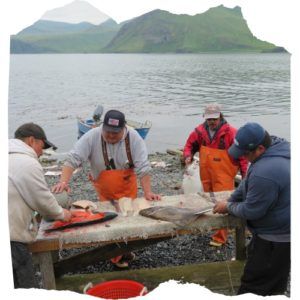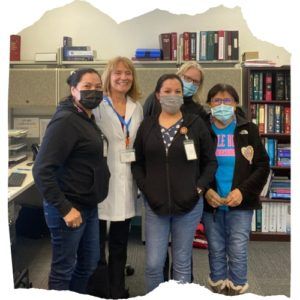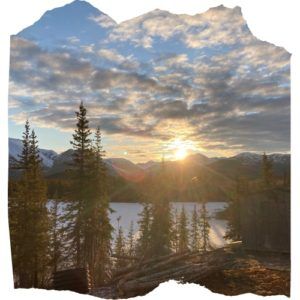Alaska is unique in many ways. It’s called “the last frontier” for good reason, and if you practice medicine in the state, especially if you’re working as a locum tenens provider, you’ll want to be prepared for unusual circumstances, delays, weather, and all things unexpected. This is all part of the Alaska lifestyle. In this article, we’ll break down what working as an Alaska locum tenens is really like.
While WMS does place locum providers in some larger cities and clinics in Alaska, most of our opportunities are in remote locations. We’ve made these sites a priority, recognizing that the populations in rural and remote settings are generally underserved and struggle to access good continuity of care.
Visit our main Alaskan Locum Tenens page: Alaska Locum Tenens
What Rural Alaskan Communities are Like
 Most communities are small; many have just a few hundred residents. Amenities and conveniences that you would expect to find even in small towns in the lower 48 may be non-existent in “the bush” of Alaska.
Most communities are small; many have just a few hundred residents. Amenities and conveniences that you would expect to find even in small towns in the lower 48 may be non-existent in “the bush” of Alaska.
When WMS places a provider in a rural medical facility, we know we’re sending that person to a unique place. The population in the community may be mostly Alaska Natives with a heritage based on hundreds of years of living in that location.
Life in these settings is reduced to fundamentals: shelter, food, appropriate clothing and gear for the climate, and the local population.
You’ll see traditional customs, native art, and native methods of food preparation on display. Racks of drying fish, collection of local foods harvested from the land, and hunting of caribou, moose, bear, and other big game are all part of everyday life in Alaskan bush communities.
There may be a small market for essential groceries, or you may be sent to a location where the recommendation is to bring your food with you. You may have your own housing, or you may have a private room within the clinic walls.
Travel for Alaska Locum Tenens Assignments
 Travel is different in Alaska too. The commercial carriers that are familiar (Alaska Airlines, Delta Airlines, American Airlines, and United) service larger communities, but to get to your final destination, if you’re going more than one stop in, you’ll almost certainly have to take a ferry, bush plane, or seaplane. That’s because so much of the state is off of the road system. Whether a community is on a far-flung island or surrounded by hundreds of miles of Arctic tundra, outside of the state’s central region, topography rules and roads are rare. It can be difficult to comprehend this until you begin to travel the state and gain first-hand knowledge of the size and challenging locations.
Travel is different in Alaska too. The commercial carriers that are familiar (Alaska Airlines, Delta Airlines, American Airlines, and United) service larger communities, but to get to your final destination, if you’re going more than one stop in, you’ll almost certainly have to take a ferry, bush plane, or seaplane. That’s because so much of the state is off of the road system. Whether a community is on a far-flung island or surrounded by hundreds of miles of Arctic tundra, outside of the state’s central region, topography rules and roads are rare. It can be difficult to comprehend this until you begin to travel the state and gain first-hand knowledge of the size and challenging locations.
Climate & Weather in Rural Alaska
The climate will almost certainly be extreme in some way, either Arctic or rainforest (although Alaska does have summer weather too). The impact of weather on life in remote locations can’t be overstated. Weather controls the ability to transport people, supplies, labs, medevacs, and any other commodity you can imagine.
Weather can also disrupt communication due to outages. You may have very limited ability to call, communicate via the internet, or pull up medical records. You certainly have to dress for the climate, and you don’t want to use discount store gloves, boots, or other inexpensive gear in Arctic temperatures. If you accept an assignment in the Far North, talk to knowledgeable people about the kind of clothing and gear you’ll need. Be prepared. These can literally be life-and-death decisions.
Entertainment & Technology in Rural Alaska
Entertainment will likely be what you choose to experience in the local community: high school basketball games or wrestling (both very big sports in the state), local festivals, or other community events; hiking, fishing, or exploring the area; and any media you bring yourself such as digital books, movies you’ve downloaded, or hobbies that can be included with your luggage. While some locations may have cable or satellite TV options, it’s best to have low expectations and be prepared to entertain yourself.
Although some modern conveniences exist, even in tiny towns, some level of internet service, phones, and transportation are pretty much everywhere. It’s safe to say that the smaller and more remote the location, the more you’ll be stepping back in time.
At the same time, you’ll see people walking around with cell phones, riding on ATVs, and hearing locals discussing events from around the world just as you would anywhere. The juxtaposition of traditional lifestyle and modern culture and technology is everywhere and can feel surreal when you experience it.
What Providing Healthcare is Like in Rural Alaska
 Healthcare will likely be a one-stop shopping opportunity for primary care, dental, and behavioral health (if that’s offered), with all specialty care or hospital-based care requiring patient travel to a larger facility.
Healthcare will likely be a one-stop shopping opportunity for primary care, dental, and behavioral health (if that’s offered), with all specialty care or hospital-based care requiring patient travel to a larger facility.
As a provider injected into a remote Alaskan medical field, you may be on your own at the community clinic. Or you may have administrative support, medical assistants, and even nursing or other providers on site. We’ll make sure you know the type of medical environment you’ll be in before you commit to an assignment.
One of our priorities at WMS is matching providers to assignments. We wouldn’t ask someone without ER skills to be a solo provider. We always want to ensure that the providers we send are up to the challenge with both training and experience to manage the demands of the practice.
The Basics of Providing Healthcare as an Alaska Locum Tenens
When you’re in remote locations, you want to know what you have to work with, where your next point of care is, and the process for initiating and launching a medevac. Clinics in remote locations should have all this information in place. Usually, at a minimum, you would have an orientation and handoff from the outgoing provider to guide you on the protocols in place for the location. (Although, full disclosure, it can happen that the outgoing provider is leaving on the plane you arrive on, and you get clinic and vehicle keys and a brief run-down as you pass each other at the airstrip.)
The rural clinics have basic equipment and supplies, but for providers coming from the lower 48, especially if you’re coming from an ER setting, you’ll find your resources are much more limited in these settings than what you’re used to. The most important skill to have is the ability to triage, stabilize, and medevac to a higher level of care. Clinics are generally not set up to keep patients overnight (unless you’re holding a patient due to a weather delay in transporting and have no choice).
Keeping a sharp eye on the weather if you have a questionable patient situation may lead to transporting the patient early to avoid complications if the weather closes in. You always have to be thinking ahead of the weather and your resources; what will you do if conditions deteriorate? If you know you can’t manage the next level of care, you don’t want to find yourself confronting that when your opportunity to medevac has passed.
The Three Things You Must Keep in Mind in Remote Medical Settings
There are three paramount things to keep in mind in these remote settings:
- First, if a patient is coming into the ER, they already have a health issue or have had an accident or traumatic event of some kind. You being there to see them and care for them is a good thing; certainly better than if there was no care available at all. Doing what you can is always going to be better than nothing, even if you feel what you can do is limited by the resources you have available.
- Second, the standard of care in remote locations is not a lower standard, it’s a different standard. It’s not possible to keep a fully supplied and staffed ER in small, isolated communities. The clinics that offer basic care and the fundamental necessities to transport a patient out to a higher-level facility are providing lifesaving services, even if the care seems primitive by big-city ER standards.You won’t have all the labs and imaging available to you in a remote clinic that you would have in a larger facility. You won’t have a wide variety of medications to choose from. You certainly won’t have surgical options available. But you will make a positive difference, just by being there and using the resources you have.
- Third, when you work in a remote location, respect the protocols and processes that are in place when you arrive. The people who live and work in the community most likely have reasons for the processes they use and may be aware of factors that aren’t obvious to someone new to the clinic or the area. Be humble and respectful and ask before you assume that your way of doing something is better.
 Your technique or process may, in fact, be better, or more cutting-edge. You may have the opportunity to teach a new skill or refine a process. But be thoughtful and diplomatic as you integrate into the existing staff and routines.
Your technique or process may, in fact, be better, or more cutting-edge. You may have the opportunity to teach a new skill or refine a process. But be thoughtful and diplomatic as you integrate into the existing staff and routines.
Remember, you’re a guest in the community and the clinic, and you’ll be more effective if you keep that in mind. Part of being a successful locum provider is having the ability to be adaptable and likable. You may not always agree with the way things are done, but your task is to do the best you can and treat the patients in your care.
WMS staff will always do what we can to make sure you’re well informed. If you’re considering working in a remote area, like Alaska, we can connect you with a provider who has recently been on-site so you can ask questions, clinician to clinician, without the filter of anyone between.
The Reality of the Rural Alaskan Medical Field
We don’t want to scare anyone away but we do want to make this point: Alaska is for people who like adventure, who can roll with uncertainty and unknowns, and who value experience over comfort and predictability. Make no mistake, remote location healthcare work is not for the faint of heart.
If you’re not comfortable making a diagnosis unless you can run every test possible (remote clinics will have limited lab and imaging capabilities); if you’re not comfortable taking your own vitals and rooming patients (you don’t always have to do this, but in some settings, you may be doing everything); if you’re easily rattled in emergencies (you’ll see everything from sore throats to traumatic injuries and life-threatening acute and chronic conditions), bush communities in Alaska are not going to be a good fit for you.
In some clinics, you might find yourself going at a fast pace all day every day. In others, you might get bored due to low patient volume and low acuity of patient complaints. It’s all part of the variety and the element of “you never know what you’ll get” in rural medical settings. You have to be ready for the Alaska lifestyle to flourish and enjoy being on assignment.
How to Know if Practicing Rural Medicine in Alaska is Right for You
 Providers who combine excellent medical skills with the enjoyment of adventure, exploration, and new experiences will do well.
Providers who combine excellent medical skills with the enjoyment of adventure, exploration, and new experiences will do well.
If you’re confident of your medical skills and yet know your limitations, enjoy meeting people and exploring new locations and cultures, like to travel, and can be flexible when weather or some unexpected event derails your schedule, you’ll fit right in as a provider in remote Alaska!
At WMS, we’re looking for the best of the best. We work with well-rounded providers who are up for a challenge. We get excited when we connect with people who share our love for serving in remote locations. When providers come back from assignments with amazing stories and photos, and are asking when they can go again, we know we’ve found a kindred spirit.
We hope you’ll join us if that sounds like an invitation too good to miss, and let us introduce you to experiences that will give you memories and connections for a lifetime!
Interested in learning more about Alaska Locum Tenens? Click here: Alaska Locum Tenens